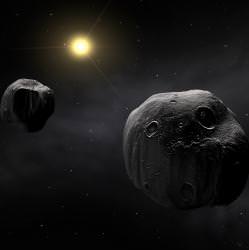 Astronomers have turned up many binary asteroids in the Solar System. Instead of a single, solitary spacerock, you’ve got two objects orbiting a common centre of gravity. A new paper published in the 2007 issue of the journal Icarus focuses on one of these double objects: the binary asteroid 90 Antiope.
Astronomers have turned up many binary asteroids in the Solar System. Instead of a single, solitary spacerock, you’ve got two objects orbiting a common centre of gravity. A new paper published in the 2007 issue of the journal Icarus focuses on one of these double objects: the binary asteroid 90 Antiope.
As late as the year 2000, astronomers didn’t even know 90 Antiope was a double object. But powerful new telescopes, such as the 10 metre Keck II observatory in Hawaii was able to use its adaptive optics system to split them up. More recent observations with the European Southern Observatory’s 8-metre Very Large Telescope have taken the observations to the next level. The observatory has helped to reveal 90 Antiope as two egg-shaped piles of rubble orbiting one another. Each asteroid is roughly 86 km (53 miles) in diameter, and they’re separated by only 171 kilometres (106 miles).
One of the most interesting observations happened in 2005, when astronomers around the world focused on the pair during a mutual eclipse or occultation. During this period, the shadow from one asteroid was expected to fall on the other, darkening their combined brightness. Right on schedule on May 31, 2005 the eclipse occurred, and astronomers were able to measure it accurately.
Original Source: UC Berkeley News Release
